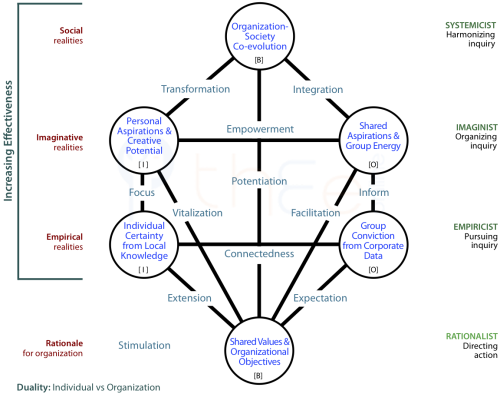Improving Control
Activities within an organization can be better controlled in the service of achievement if inquiry is brought to bear, and if the achievement tensions are directly handled.
Increasing Effectiveness
The upper section, , is about increasing effectiveness.

. The meaning of effectiveness in regard to achievement is provided by the of the organization, which direct all action.
. Corporate data and personal knowledge provide confidence about what has happened and what is going on, and also shape what might and can be planned. Unlike , these realities are not intangible forces but brute factors that require respect and adaptation. So staff must actively pursue inquiry.
. Aspirations can be created, and once created they are forces that push and pull people: enlivening values, inspiring bold objectives and stretching everyone gratifyingly. Aspirations are therefore the necessary context for organizing inquiry.
. These realities are also forces, but now impersonal and wholly independent of individuals. Such forces cannot be controlled, and they cross organizational boundaries.
Taking a systemicist view harmonizes inquiry, based on differing ideas or aspirations or evaluations, which could otherwise lead to clashes.
Handling Tensions
in the (CL4) is the primary link between Inquiry-Centres that increase effectiveness and Action-Centres that control activity.

● All Centres in the upper 3 levels have direct channels of influence to.
● All but one Centre in the lower 3 levels have direct channels of influence to .
The is the wild card: not only does it lack a direct link to , but it can bypass —and will certainly do so if roles and reporting relationships are confused and weak.
The only other links between the two halves of the Tree are . These links have two effects in relation to duality-based tensions:
► bridging the internal duality i.e. effectiveness control is linked more solidly with activity control
► bridging the «individual v organizational» dynamic duality i.e. the counter-pointing of individuals' values and knowledge with those of the organization is sharpened.
Selection of is the primary method of management to force viable resolution to power-based disputes: . The powerful groups use data in a similar fashion to press their case. Such data may be used to define resolutions which may well lead to further confrontations
We name the channel: CONFRONTATION
of specific examples of work issues and problems is usually invaluable in developing a resolution to structural and managerial conflicts: . The resolution of such issues encourages and stimulates a better understanding of local situations.
We name the channel: STIMULATION
![]()
- Consider a paradox revealed by this structure.
- Look at the application to employees.
- Look at the application to entrepreneurs.
Originally posted: 29-Sep-2011